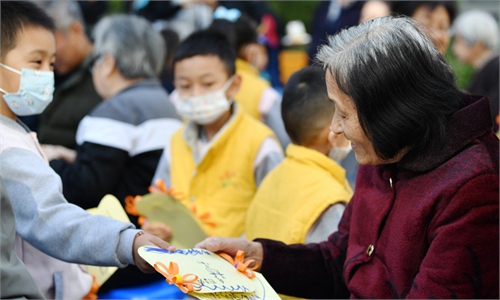
Parents holding their children play in the square of a residential community in Nanjing, capital of East China's Jiangsu Province. Photo: VCG
Statistics show that eight Chinese cities have recorded a negative natural population growth in 2020, although the central government has not yet released the specific data on the overall situation from the seventh national population census.
The eight cities are Taizhou, Yangzhou, Zhenjiang, Changzhou and Wuxi in East China's Jiangsu Province, Fushun and Shenyang in Northeast China's Liaoning Province, and Weihai in East China's Shandong Province, according to a report by 21st Century Business Herald published on Tuesday, citing demographic data revealed by 26 cities across the country.
Among them, Fushun has the lowest natural growth rate of -13.3 per 1,000 population. As a whole, almost all of the cities that reported their natural population growth rates in 2020 showed declines compared with 2019.
Experts said that the growth or contraction of the population in individual cities cannot fully explain China's population development trend. However, they predict that China as a whole would see a negative population growth in 2027 or 2028.
In fact, negative population growth in some cities is not new and the natural population trend in a city is influenced by a variety of factors, including a decline in births, ageing populations and emigration, Peng Xizhe, Director of the Fudan University Center for Population and Development Policy Studies told the Global Times on Wednesday.
In the past five years, among the 41 cities in the Yangtze River Delta,including Shanghai, 17 cities have seen decline in the natural population growth rate while the others recorded an increase, Peng explained, adding that this is partly caused by regional population mobility.
But indeed, as a whole, China is seeing a declining birth rate. In the past four years, the number of newborns in China dropped from 17.25 million in 2017 to 14.65 million in 2019. According to a report published in February by a research center under the Ministry of Public Security, the number of newborn babies registered with public security organs in 2020 was 10.04 million, 15 percent down from the previous year.
The birth rate on the Chinese mainland dropped to 10.48 per 1,000 people in 2019, the lowest in seven decades, according to the National Bureau of Statistics.
There is an inertia in the development of population, Peng said. People currently at child-bearing age in China are those born after the 1990s, many of whom do not have much interest in having a child. As a result, the projected number of new births will continue to decline for some time.
Chinese population experts predict that China's annual births may fall below 10 million and calls for the country to lift restrictions in the number of births.
China's central bank published a working paper on April 14 recognizing that China's demographic situation has reversed, its population will contract faster than expected after the transition, and education and technological progress will hardly compensate for the population decline.
Apart from removing family planning restrictions from laws and regulations and make childbearing a matter that individuals and families can decide by themselves, China needs to promote births by creating a friendlier social environment with equal employment and educational opportunities for men and women and making the distribution of social resources fairer and equal, Peng noted.
"Experience of some foreign countries suggest that policy incentives are rarely effective or have limited impacts. People are less affected by policies than by socio-economic environment, reproductive costs and concerns about the development of women's careers." Peng said.
China kicked off its seventh national population census in November 2020 with results scheduled to be released in early April. However, the final report has not yet been released sparking speculations from the general public.
Liu Aihua, spokesperson of the National Bureau of Statistics, said at a press conference on April 16 that work will pick up to release the final results of the census to the public as soon as possible.



